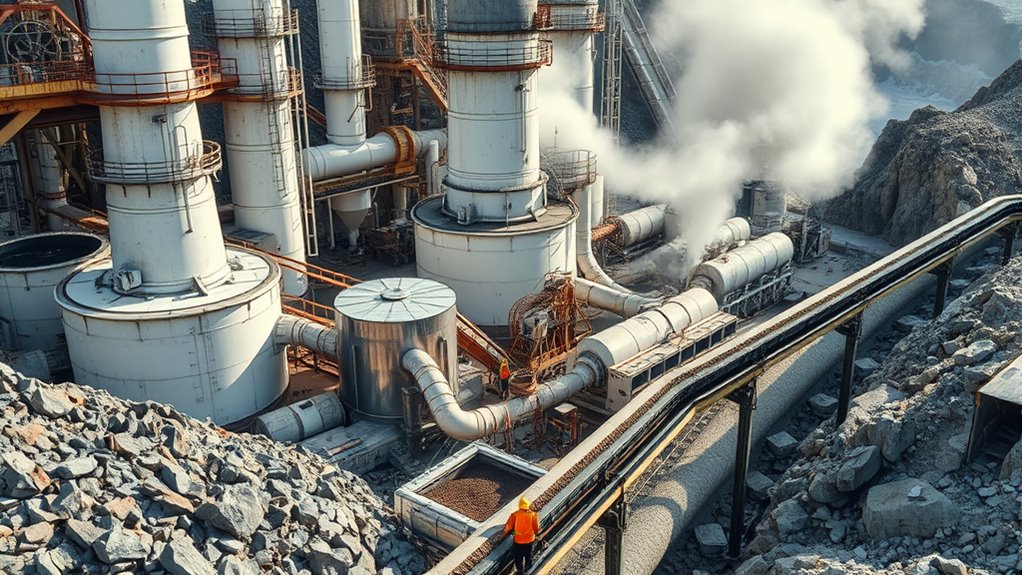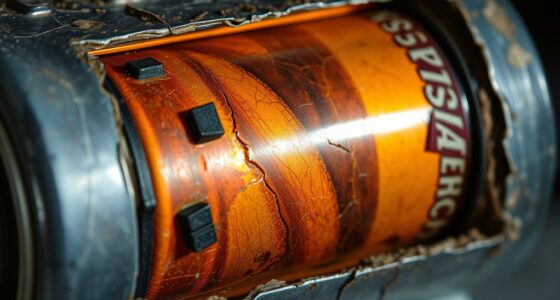To recover lithium, nickel, and cobalt from batteries, you typically dismantle the used units carefully. Then, chemical methods like leaching dissolve these metals for separation, while mechanical processes break down components for easier extraction. Lithium is often purified through melting or dissolving techniques, and nickel and cobalt are leached out chemically. These efficient methods maximize recovery and help reuse valuable materials. If you’re curious about the detailed steps, you’ll find more insights ahead.
Key Takeaways
- Lithium is recovered through hydrometallurgical or pyrometallurgical processes involving dissolution or melting.
- Nickel and cobalt are extracted via chemical leaching from battery components.
- Mechanical disassembly separates batteries into manageable parts for chemical processing.
- Recovered materials are purified and reintegrated into manufacturing cycles.
- Recycling methods prioritize efficiency, safety, and environmental protection to prevent pollution.

Material recovery is a essential process that involves extracting valuable materials from waste to reduce environmental impact and conserve resources. When it comes to batteries, this process becomes especially important. Battery recycling plays a key role in reclaiming lithium, nickel, and cobalt, which are indispensable components of many modern electronics and electric vehicles. By recycling these materials, you prevent them from ending up in landfills, where they could leach harmful substances into the soil and water, markedly reducing the environmental impact of battery disposal.
When you participate in battery recycling, you directly contribute to lowering the demand for virgin mining. Extracting lithium, nickel, and cobalt through traditional mining methods consumes vast amounts of energy, disrupts ecosystems, and produces pollution. Recycling batteries minimizes these negative effects by reusing already-processed materials, which requires less energy and reduces greenhouse gas emissions. This sustainable approach helps preserve natural resources and mitigates the environmental footprint associated with raw material extraction.
The process of recovering these materials involves carefully dismantling used batteries and processing their components through various chemical and mechanical steps. Lithium, for example, is usually extracted via hydrometallurgical or pyrometallurgical methods, where the materials are dissolved or melted, then purified for reuse. Nickel and cobalt are similarly recovered through chemical leaching. These methods are designed to maximize yield while minimizing waste, ensuring that each battery’s valuable components are efficiently reclaimed and reintegrated into manufacturing cycles.
Understanding the environmental impact of battery recycling also means recognizing its potential to reduce pollution and energy consumption. Recycling facilities implement strict controls to avoid releasing hazardous substances during processing, and advancements in technology continue to improve the efficiency and safety of these operations. By recycling batteries, you’re not only conserving resources but also helping prevent the release of toxic elements into the environment, which can harm ecosystems and human health.
Frequently Asked Questions
What Are the Environmental Impacts of Lithium, Nickel, and Cobalt Extraction?
You should know that extracting lithium, nickel, and cobalt causes significant environmental pollution and habitat destruction. Mining processes often release toxic chemicals into soil and water, harming ecosystems and communities. Open-pit mining destroys landscapes, displacing wildlife and damaging habitats. These activities also emit greenhouse gases, contributing to climate change. Being aware of these impacts helps you understand the importance of sustainable practices and the need for responsible sourcing to protect our environment.
How Do Recycling Methods Compare to Primary Mining in Efficiency?
You might think recycling is just a trendy buzzword, but it actually beats primary mining in efficiency. Recycling methods often reclaim a higher percentage of lithium, nickel, and cobalt, making resource sustainability a real possibility. Plus, they cut down environmental impacts and reduce the need for risky extraction. So, if you’re serious about saving the planet, recycling isn’t just smart — it’s essential for smarter resource management.
What Innovations Are Emerging in Material Recovery Technologies?
You’ll see innovative extraction methods like hydrometallurgy and bioleaching gaining traction, improving efficiency and reducing environmental impact. Recycling advancements now enable you to recover lithium, nickel, and cobalt more effectively from batteries and electronic waste. These innovations make material recovery more sustainable and cost-effective, allowing you to minimize reliance on primary mining. As technology evolves, expect faster, greener, and more scalable solutions to meet global demand for critical materials.
How Does Geopolitical Stability Affect Supply Chains for These Metals?
Geopolitical stability critically shapes your supply chains for lithium, nickel, and cobalt. Trade sanctions and regional conflicts cause chaos, creating cracks in your sourcing strategies. You might face delays, increased costs, or shortages, forcing you to seek alternative sources or diversify suppliers. When nations wobble on the global stage, your access to these vital metals wavers, making stability essential for secure, steady material recovery and supply chain resilience.
Are There Ethical Concerns Related to Mining Practices for These Materials?
Yes, there are ethical concerns around mining practices for lithium, nickel, and cobalt. You should consider ethical sourcing, ensuring the materials come from responsibly managed mines. Labor practices are often problematic, with issues like child labor and unsafe working conditions. By supporting companies that prioritize transparency and fair labor practices, you can help promote more ethical and sustainable extraction methods for these critical materials.
Conclusion
So, next time you toss that old phone or car battery, imagine your discarded tech turning into a treasure map—if only you knew where to dig. Lithium, nickel, and cobalt don’t just vanish; they’re quietly reborn through complex extraction, like a phoenix rising from the ash. Just remember, in this game of resource roulette, you’re the unwitting dealer, handing over valuable metals for a future where we might finally learn to recycle without playing hide-and-seek with Mother Earth.










